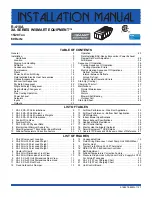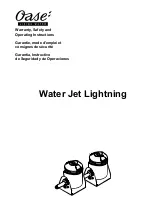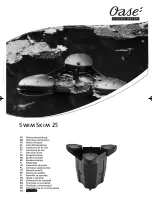
Technical staff manuall
11
1
– gas removal device branch pipe; 2 - casing; 3 – viewing window;
4
– gas consumption tap knob; 5 - fitting of cold water supply, screw thread G 1/2;
6 - fitting of gas supply, screw thread G 1/2; 7 - fitting of hot water output, screw thread G 1/2;
8
– mounting holes
Scheme 1. Overall and connection dimensions of the appliance
3. USAGE OF THE APPLIANCE
For normal and safe appliance operation the conditions presented in p. 2.2.9, 2.2.15 and 2.2.18 (see Table 1,
page 4) must be fulfilled.
Non- compliance with these conditions can cause the
appliance’s inappropriate or
unstable operation and even its breakdown. The heating effect of the appliance indicated in the p. 2.2.2
is
provided (with an accuracy ±5%) at rated gas pressure on the inlet into the operating appliance, indicated in the
Acceptance certificate.
3.1.
Putting the appliance into operation
3.1.1. In order to put the appliance into operation in a general case it is necessary to:
a)
Install the power element into the battery section (see p.3.4, page 8);
b)
Open the stop valve of cold water by the inlet into the appliance;
c)
Open the stop valve on the gas pipeline by the inlet into the appliance
d)
Open the hot water tap, while spark discharges should appear between the plug and ignition burner (if the water
flow going through the appliance will be at least 2.5 l/min), from the spark discharges the ignition burner should
ignite and from the ignition burner the main burner should ignite. After igniting the main burner the ignition
burner’s flame must go out.
ATTENTION!
To avoid burns, do not approach your eyes too close to the viewing window while the
appliance is being switched on
.
Note:
At first launching of the appliance or after long-
term period of break in appliance’s operation, the ignition
burner’s ignition will occur only after air removal out of gas pipeline. As the spark discharges last not more than 60
seconds after switching the water on, for continuing the ignition it s necessary to close the hot water tap, and then open
it again. You need to repeat this procedure until complete air removal out of the pipeline and until the ignition burner
ignites.
3.1.2. Changing of water consumption with which switching the appliance on and off occurs is effectuated by the
knob of the tap 15 (scheme. 14, 15, 16). Turning the knob 15 clockwise (counterclockwise) leads also to
reduction (increase) of consumption of water running through the water heater.
Switching the appliance on at leftmost position of the knob of the tap 15 (minimal water consumption
– see
scheme 14, 15, 16) occurs at water consumption 2,5 l/min, switching off - at 2 l/min. Such knob position is
recommended at low inlet water pressure (with small consumption of water provided by the water supply network).
Switching the appliance on at rightmost position of the knob of the tap 15 (maximal water consumption) occurs at
water consumption 3 l/min, switching off-at 2,5 l/min. With such knob position it is possible to receive increased
consumption of heated
water by the appliance’s outlet.
3.2. Water temperature regulation
3.2.1
Water temperature regulation at t
he appliance’s operation.
3.2.2
Water temperature regulation by the appliance’s outlet can be effectuated in one of the following ways:
a) Turning the knob 4 of the gas consumption tap of the appliance (see Scheme 2, Scheme 3): turning the
knob clockwise to the position
“Minimal consumption”
reduces gas consumption and water temperature,
turning the knob counterclockwise to the position
“Maximal consumption”
increases gas consumption
and water temperature;
b) .changing the consumption water running through the appliance by the hot water tap: increasing water
consumption (at consumption of more than 4…6 l/min) leads to its temperature reduction, water
consumption increase leads to its temperature reduction
Summary of Contents for NEVALUX-5514
Page 18: ......










































